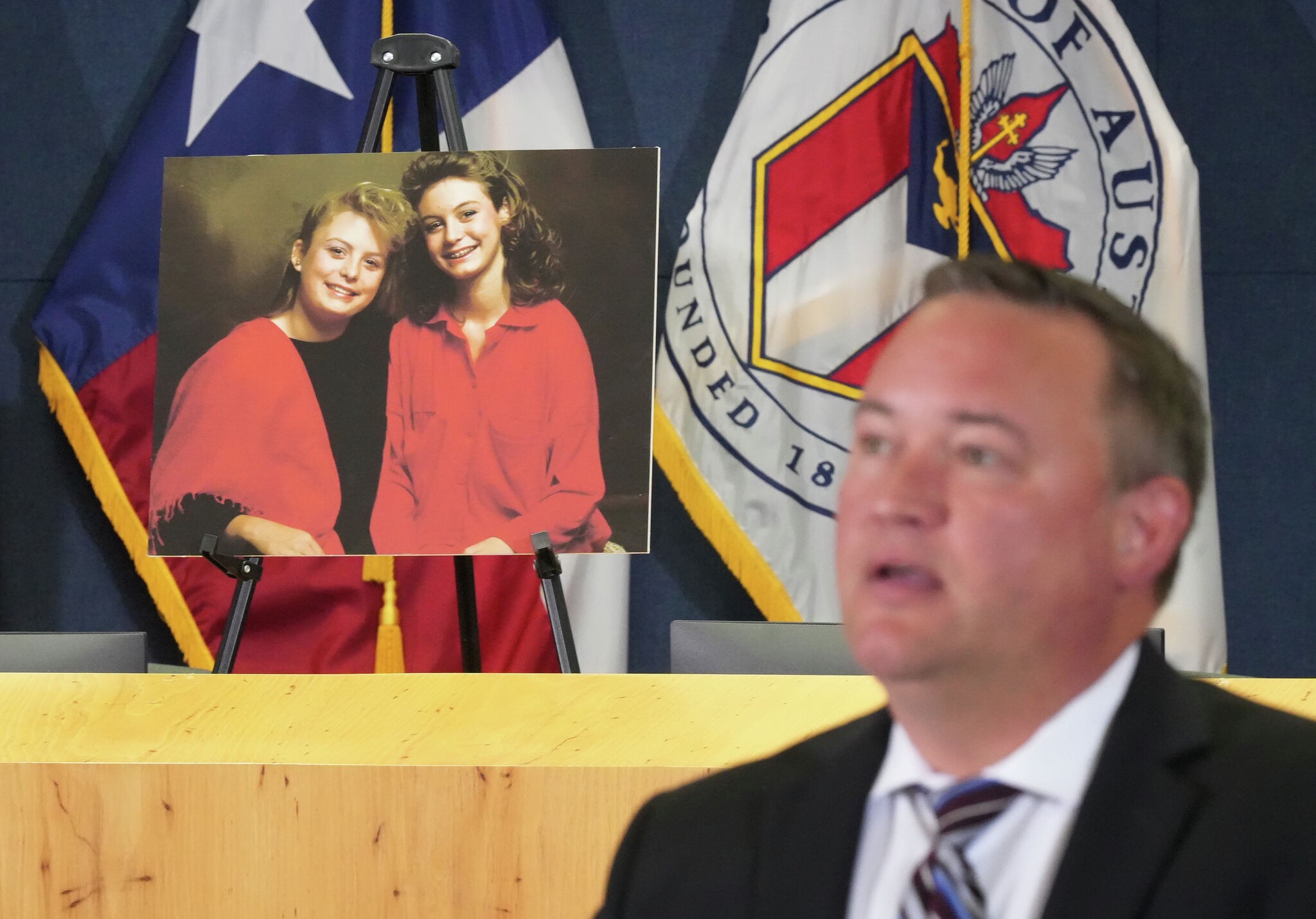news
Scientific breakthroughs helped solve Austin yogurt shop murders case
Austin police partnered with genealogical experts who traced an unknown DNA sample found at the crime scene to Brashers.
Published September 30, 2025 at 11:00am by Dante Motley

With a photo of sisters Jennifer and Sarah Harbison in the background, Austin Police Department Cold Case Detective Daniel Jackson speaks at a news conference at City Hall about the 1991 I Can’t Believe It’s Yogurt murder investigation on Monday, Sept. 29, 2025.
More than three decades after the horrific slayings of four teenage girls at an Austin frozen yogurt shop, police said they finally have a definitive culprit.
The Austin Police Department announced last week that DNA evidence had linked the killings to Robert Eugene Brashers, a convicted felon and serial predator who died by suicide in 1999. During a Monday press conference, officials repeatedly credited advancements in science and technology with enabling investigators to match decades-old evidence to Brashers and close the notorious case.
The deaths of 17-year-old Eliza Thomas, 13-year-old Amy Ayers, 17-year-old Jennifer Harbison and her 15-year-old sister Sarah at the I Can’t Believe It’s Yogurt shop in Austin remained unsolved for 34 years. Investigators preserved DNA, but early profiles were too limited and degraded to yield a match.
Advancements in ballistics analysis and cutting-edge DNA testing, combined with investigative genetic genealogy, were key to the breakthroughs, leading investigators across the country in their search for the serial killer and rapist.
What advancements in ballistics help catch Brashers?
The only solid physical evidence left at the scene of the crime was a .380 bullet casing found in a floor drain.
In June, after working the case for two years, Austin police Detective Daniel Jackson realized he hadn't checked the National Integrated Ballistic Information Network in some time. The network is a nationwide system operated by the Bureau of Alcohol, Tobacco, Firearms and Explosives that uses digital imaging to compare shell casings from crime scenes and link shootings to the same weapon across jurisdictions.
Police had run the shell through the data before, but since then the network had grown more advanced, Jackson said. Over the past few decades, the National Integrated Ballistic Information Network has expanded dramatically, with sharper imaging technology, faster turnaround times and broader coverage across the country. And advances like 3D topographical imaging have improved accuracy in matching shell casings.
On July 2, police ran the bullet though the network again. This time, a match turned up in Kentucky.
Investigators traveled there and compared the casing, finding it was highly likely fired from the same type of gun.
Kentucky detectives then pulled out their own sexual-assault kit with DNA evidence. The DNA matched Austin’s existing DNA profile, confirming a link between the cases and prompting Austin police to request a new nationwide manual search of crime-lab databases.
That search uncovered a match in Greenville, South Carolina — a 1990 sexual assault and murder. Brashers had already been identified as a likely suspect in that case in 2018 through investigative genetic genealogy.
What advancements in DNA helped catch Brashers?
When the yogurt shop murders first occurred in 1991, DNA analysis was in its infancy. But detectives still had the foresight to swab for DNA in case the technology ever improved.
Investigators preserved a Y-STR DNA profile, a male-only genetic marker that can show links across paternal family lines. But the profile contained only 16 markers — specific locations on the Y chromosome used to measure genetic variation. With fewer markers, the results are less distinctive, making it harder to distinguish one individual's lineage from another's. No match was found.
In 2018, the DNA was analyzed again, this time yielding 27 markers, but investigators still found no match.
But the more complete profile developed using the evidence from Kentucky sparked new hope that police would be able to find a match. Because Y-STR searches rarely produce results in standard databases, Austin police had to request that labs nationwide run manual tests against the new profile.
When an analyst in South Carolina uploaded the yogurt shop sample, they got a match.
That breakthrough built on earlier genealogical work in 2018, when investigators used investigative genetic genealogy to identify Brashers as the likely suspect in multiple unsolved murders. IGG compares DNA evidence from a crime scene with profiles in public or consumer genetic databases. If a direct match isn’t available, genealogists build out family trees using partial matches and then narrow the search to possible suspects.
The rising popularity of consumer genetic testing in recent years, through services such as Ancestry.com and 23andMe, has made IGG possible by increasing the number of profiles in the pool. In addition to criminal investigations, the method can also be used to identify unidentified human remains.
In the Austin case, the preserved DNA was linked to a 1990 Greenville sexual assault and murder with a similar Y-STR profile. But it didn't provide absolute certainty. When investigators re-tested DNA from under Amy Ayers’ fingernails, they finally got a usable result — a match to Brashers with odds of about 2.5 million to 1. Combined with the rare Y-STR links and the South Carolina hit, that evidence gave police the confirmation they needed.
A growing list of closed cold cases
The yogurt shop murders are now part of a growing list of unresolved cold cases that have been cracked by IGG. Since the method emerged in 2018, it has been applied to hundreds of cases to generate leads.
California investigators used IGG in 2018 to identify the Golden State Killer in one of the technique’s first — and most high-profile — success stories. Joseph James DeAngelo was identified as the man responsible for at least 13 murders and dozens of rapes in the 1970s and 1980s.
Police in Austin used IGG just last year to solve the murder of Bert Allen Mann, who was stabbed in his home in 1994. The case had been cold for 30 years.

